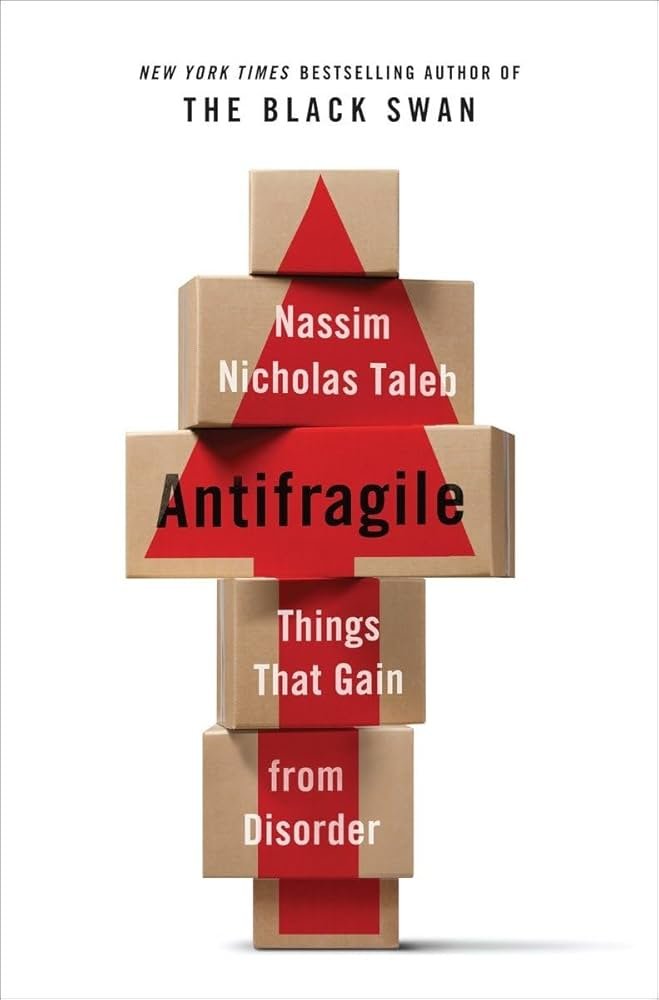
Test1

In Antifragile, Nassim Nicholas Taleb introduces the powerful concepts of antifragility and resilience, challenging the conventional understanding of risk and uncertainty. Unlike systems that break down under stress, the antifragile thrive and grow stronger. In today’s unpredictable world, individuals must understand and embrace resilience and antifragility. These concepts are crucial for personal, financial, and societal growth. Taleb’s groundbreaking ideas encourage readers to reconsider the value of stability and predictability. Instead, they promote a mindset that thrives amidst chaos and adversity. This article will explore these concepts and show how adopting an antifragile approach can help individuals and organizations flourish in times of uncertainty.
Basic Info
📖 Title: Antifragile: Things That Gain from Disorder
✍️ Author: Nassim Nicholas Taleb
📅 First Published: 2012
🗣️ Original Language: English
📚 Genres: Economics, Philosophy, Risk Management
📐 Structure: 5 parts
📄 Pages: Approximately 500
🎚️ Reading Level: Advanced (concepts of risk, uncertainty, and systems)
👥 Main Focus: The concept of antifragility, risk, and systems that improve from disorder
🎭 Themes: Uncertainty, resilience, risk management, unpredictability
🌟 Famous For: Introducing the concept of antifragility, a new way of thinking about risk and uncertainty
🏆 Influence: Widely cited in economics, business, and risk management fields
🚫 Controversies: Its rejection of traditional risk management practices and mainstream economic theory
📅 Notable Dates: Influential in the 2010s, has been referenced in academic and popular discussions on risk
Key Themes and Concepts from ‘Antifragile’
Taleb’s central thesis in Antifragile is that certain systems, entities, and phenomena are not just resistant to shocks or disruptions but actually become better and more robust as a result of them. He contrasts antifragility with fragility and robustness, explaining the following key ideas:
- Antifragility vs. Fragility: While fragile systems break under stress, antifragile systems become stronger. Taleb applies this to economics, business, and personal life, arguing that disorder and volatility are essential for progress and growth.
- The Barbell Strategy: Taleb proposes a strategy for managing risk that involves balancing highly risky, high-reward bets with very safe, low-risk investments. This allows individuals or organizations to benefit from both extremes while avoiding the middle ground of moderate risk, which he sees as dangerous.
- Via Negativa: This concept revolves around the idea that less is often more. Taleb advocates for removing unnecessary elements in systems (whether it’s in business, government, or personal life) rather than adding more complexity, which often leads to fragility.
- Skin in the Game: Taleb emphasizes the importance of individuals and institutions having a personal stake in the outcomes of their actions. He argues that those who benefit from a system should also bear the risks, a principle that he believes would lead to more ethical and sustainable decision-making.
- The Procrustean Bed: A metaphor Taleb uses to critique modern society’s tendency to force complexity into simplified models that fit preconceived frameworks, often overlooking the reality of how things work in practice.
Chapters Overview
Antifragile is divided into seven parts, each exploring how systems, individuals, and organizations can thrive under uncertainty, stress, and chaos. Below is a breakdown of its structure and key chapters.
- Part 1 – Between Damocles and the Antifragile: This section introduces antifragility, contrasting it with fragility. Some things improve under stress, while others weaken. Thriving through adversity becomes a key theme.
- Part 2 – Modernity and the Greatness of the Antifragile: Society has moved away from randomness, creating fragile systems. Understanding and applying antifragility helps counter modern vulnerabilities.
- Part 3 – The Individual and Antifragility: Individuals can grow by embracing stress and adversity. Challenges strengthen rather than break them, fostering resilience and adaptability.
- Part 4 – The Fragility of Modern Institutions: Institutions seek stability but often create fragility instead. Prioritizing control over flexibility makes them vulnerable to unexpected disruptions.
- Part 5 – The Business World and Antifragility: Businesses that embrace volatility turn instability into growth opportunities. Risk, when managed well, drives long-term success.
- Part 6 – Antifragility and Society: Societies that accept unpredictability build resilience. Adapting to change, rather than resisting it, strengthens communities against future challenges.
- Part 7 – Conclusion – Building an Antifragile Life: Practical strategies help individuals and organizations incorporate antifragility. The book offers steps to build resilience and thrive in uncertain environments.
Impact and Reception
Since its publication, Antifragile has become a seminal work in economics, philosophy, and risk management.It has received widespread praise for its innovative approach to thinking about uncertainty. Its influence extends beyond academia into the business world, where companies and individuals incorporate Taleb’s ideas into their strategies. Many entrepreneurs, investors, and policymakers have adopted Taleb’s approach to risk, which prioritizes resilience over predictability.
However, Antifragile has also faced criticism. Some argue that Taleb’s philosophy, while compelling, is difficult to apply in real-world policy-making. Others have pointed out the book’s confrontational tone and its occasional vagueness in offering practical solutions. Despite these criticisms, Taleb’s work continues to challenge conventional thinking and provoke debate.
Relevance Today
In an era defined by volatility, uncertainty, and rapid technological change, the concept of antifragility is more relevant than ever. Global markets, political systems, and social structures are increasingly subject to unforeseen disruptions, whether due to economic crises, pandemics, or technological advancements. Taleb’s work offers valuable insights for navigating this uncertainty, encouraging readers to embrace risk rather than avoid it.
The book also finds relevance in today’s debates on sustainability and resilience. With issues like climate change, global inequality, and geopolitical instability on the rise, understanding how to build systems that can thrive in the face of adversity is crucial for long-term survival and success.
Conclusion
Antifragile is a transformative book that offers a new perspective on how we understand risk, uncertainty, and resilience. Taleb’s ideas challenge conventional wisdom and encourage readers to rethink complex systems, from economics to personal life. Whether or not you agree with all his conclusions, Antifragile offers a valuable framework for navigating our unpredictable world. For anyone interested in economics, risk management, or the philosophy of uncertainty, this book is an essential read.


